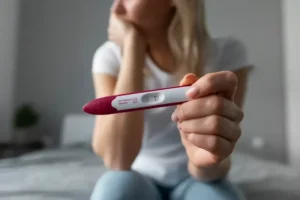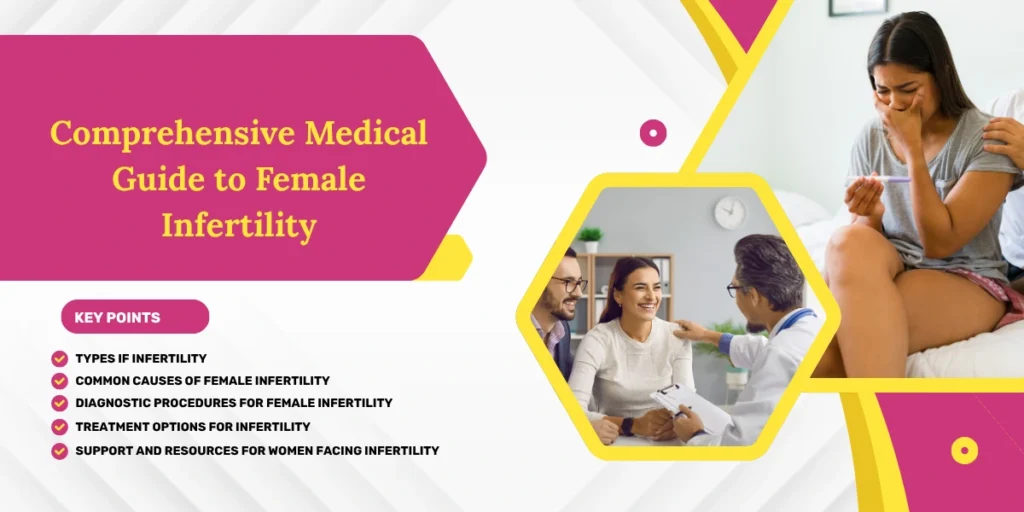What Are Main Causes of Female Infertility: Medical, Lifestyle & Environmental Insights
Introduction
Infertility is a significant challenge affecting millions of women worldwide. The main causes of female infertility span medical, structural, lifestyle, and environmental factors. Understanding these drivers is essential for early diagnosis, effective treatment, and emotional well-being.
In this comprehensive guide, you’ll explore those root causes and find out how tools like hormone score calculators and partner health blogs can support your journey toward conception.
1.What Is Female Infertility?
Female infertility is usually defined as the inability to conceive after 12 months of regular, unprotected intercourse or the inability to carry a pregnancy to term.
of regular, unprotected intercourse or the inability to carry a pregnancy to term.
The main causes of female infertility include anything from ovulation issues to uterine abnormalities that affect a woman’s ability to conceive or sustain a pregnancy.
Plan your pregnancy with the Pregnancy Planner — calculate fertile windows and ovulation dates.
2.Prevalence & Importance
Approximately 1 in 8 couples face infertility challenges, with female factors contributing to nearly half of those cases. Highlighting the main causes of female infertility helps reduce stigma, encourages timely medical consultation, and improves reproductive outcomes.
3.Main Causes of Female Infertility
a) Ovulatory Disorders
Irregular or absent ovulation— mainly due to PCOS or hormonal changes. one of the main causes of female infertility. Thyroid issues and pituitary glandes disorders also disrupt ovulation and menstrual regularity.
b) Structural Reproductive System Issues
Conditions like endometriosis, uterine fibroids, uterine adhesions, blocked fallopian tubes, and congenital uterine anomalies are all among the main causes of female infertility. These structural barriers can prevent sperm from reaching the egg or hinder embryo implantation.
c) Age-Related Decline
Aging significantly affects egg quality and quantity. After age 35, women’s ovarian reserve diminishes rapidly, making age one of the most critical of female infertility.
d) Hormonal Imbalances
Low estrogen, progesterone issues, and luteal phase defects are also major main causes of female infertility.
e) Lifestyle & Environmental Factors
Unhealthy habits such as insulin resistance from poor diet, obesity, smoking, alcohol use, and excessive caffeine are among the main causes of female infertility. Environmental toxins, radiation, and pollutant exposure further contribute to fertility issues.
4.Diagnosis & How to Identify the Causes
A comprehensive evaluation targets the female infertility through:
- Detailed medical and menstrual history
- Hormonal blood tests (FSH, LH, estrogen, progesterone)
- Imaging: transvaginal ultrasound, HSG for tube patency
- Diagnostic laparoscopy for endometriosis or structural assessment
Use the Estrogen & Progesterone Score Calculator to track your hormone profile before or after consulting your provider.
5.Treatment Approaches
Addressing the female infertility takes a personalized approach:
- Ovulation Induction (e.g., clomiphene, letrozole)
- Surgery for fibroids or endometriosis
- ART: IUI or IVF, especially when structural or genetic factors are involved
- Hormone Therapy for endocrine-related causes
- Lifestyle support: diet, weight management, reducing toxin exposure
Emotional & Psychological Support
Facing the female infertility can be emotionally taxing. Support groups, counseling, and open communication with partners are vital for coping and resilience.
When Male Factors Also Matter
Sometimes, female infertility is paired with male factors. For insight into related fertility challenges, check out our articles on ED:
- main causes of male infertility
- Does Lisinopril Cause Erectile Dysfunction?
- Can Blood Thinners Cause ED?
6.Prevention
Proactively avoiding risk factors
- Maintain a healthy BMI
- Eat balanced, antioxidant-rich foods
- Manage stress and maintain sleep hygiene
- Avoid smoking, limit alcohol, reduce environmental exposures
Conclusion
The main causes of female infertility are varied and intertwined from medical conditions and hormonal imbalances to lifestyle and environmental influences. With proper diagnosis, treatment, and support, many women successfully conceive. Use our calculators and related resources to guide your fertility journey.
FAQs
What are the first steps to take if I suspect infertility?
The first step is to visit a healthcare provider for a comprehensive evaluation. A detailed medical history and initial tests can help determine if there is an underlying cause of female infertility.
How does age affect female fertility?
As women grow older, both the quality and quantity of their eggs decrease, which can make conception more challenging, particularly after the age of 35.
Are there natural remedies that can improve female infertility?
While some natural remedies may help regulate menstrual cycles or balance hormones, there is limited evidence supporting their effectiveness in treating infertility. Always consult with a healthcare provider before pursuing natural treatments.
What lifestyle changes can enhance female infertility?
Maintaining a healthy weight, exercising regularly, quitting smoking, and reducing alcohol intake can all have a positive impact on fertility.
How can partners be involved in the female infertility journey?
Infertility is a shared experience, and it’s important for both partners to communicate openly and support each other throughout the process. Both partners may also need to undergo testing to determine if male infertility is contributing to the difficulty in conceiving or female infertility.
By providing accurate information, understanding the emotional journey, and offering practical support, women can be empowered to take the next steps toward building their families.
References
- American Society for Reproductive Medicine (ASRM). Female Infertility: Causes and Diagnosis.
https://www.reproductivefacts.org/news-and-publications/patient-fact-sheets-and-booklets/documents/fact-sheets/female-infertility/ - Mayo Clinic. Infertility in Women: Symptoms, Causes, and Treatments.
https://www.mayoclinic.org/diseases-conditions/infertility/symptoms-causes/syc-20354317 - WebMD. Female Infertility Overview and Risk Factors.
https://www.webmd.com/infertility-and-reproduction/guide/female-infertility - Cleveland Clinic. What Causes Female Infertility?
https://my.clevelandclinic.org/health/diseases/21821-infertility-in-women - NIH – MedlinePlus. Female Infertility: Causes and Diagnosis.
https://medlineplus.gov/infertility.html - Fertility and Sterility Journal. Impact of Age, Lifestyle, and Environmental Factors on Female Fertility.
https://www.fertstert.org/article/S0015-0282(20)30827-2/fulltext - Verywell Family – Reproductive Health. Lifestyle and Environmental Influences on Female Fertility.
https://www.verywellfamily.com/female-fertility-factors-1960202


